Magic The Gathering – Phyrexia: All Will Be One Cards And Changes

It’s been over two months since the release of last Magic: The Gathering set, “The Brothers’ War.” There, the original Magic plane of Dominaria was under attack by one of the most evil forces in the Multiverse. Now, it’s time to head to the plane behind the invasion, and take on the enemy in their home turf.
Welcome to “Phyrexia: All Will Be One.” Unlike the relatively peaceful blue skies and natural oases of Dominaria, the plane of New Phyrexia is a twisted fever dream–one full of death, decay, and metal monstrosities held together by tissue and tendon. At the helm is the loathsome leader, the “Mother of Machines”: Elesh Norn.
Phyrexia: All Will Be One (ONE) is a large set, bringing 271 new cards into rotation. Both flavorfully and mechanically, it is a much different landscape than the previous two Dominaria-based sets we played with. To tackle your prerelease, or get a head start on building new decks for constructed, you’ll want to have an understanding of everything going on in ONE.
Here’s where to start. Welcome to metal hell.
New and returning mechanics
Like any set, ONE brings to the table a mix of returning, reimagined, and brand-new card mechanics. Whether you’re building a sealed deck at your prerelease, or brewing up something spicy for standard, you’ll want to know how these mechanics operate and interact to get a competitive edge.
Here are the main set mechanics to be on the lookout for:
Toxic
Poison counters are back, this time in the form of a new keyword ability known as “toxic.”
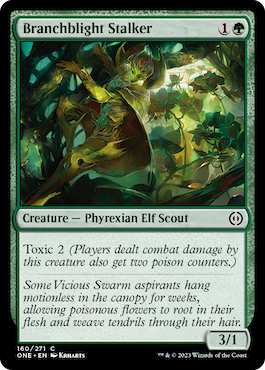
Unlike the vast majority of counters you’ll encounter in Magic, poison counters are placed on players, rather than any permanents on the battlefield. When a player gets 10 or more poison counters, they lose the game. Poison damage, in other words, effectively halves your life total.
Toxic is similar to the old mechanic “infect,” but not exactly the same. Whereas poison counters dealt by creatures with infect was always equal to their power, a toxic creature’s power and toxic number can be different. When Branchblight Stalker deals damage to a player, for example, that player takes 3 normal damage and gains 2 poison counters. Also, toxic creatures deal normal damage to creatures in combat, whereas infect creature dealt combat damage in the form of -1/-1 counters.
In ONE, toxic is most heavily supported in white, black, and green. Green, naturally, has a high density of beefy creatures with high toxic numbers (all the way up to toxic 6), whereas white shines at flooding the board with 1/1 Phyrexian Mite artifact creature tokens with toxic 1. Be on the lookout for toxic creatures with evasive abilities, such a flying or trample. The sooner you can get the toxic train rolling, the sooner you can poison your opponent out of the game.
Corrupted
Closely related to toxic is “corrupted.” Corrupted is an ability word that grants your cards additional abilities or benefits if an opponent has three or more poison counters.

Anoint with Affliction, for example, is an instant that exiles a creature with mana value 3 or less at its baseline. But with corrupted online, it can exile any creature instead. In other cases, corrupted can grant power and toughness bonuses, mana cost reduction, and other number of other effects.
Corrupted shows up mostly in white and black, with a couple of instances in blue and green, as well. Worth noting, it is not as common a mechanic as toxic in ONE; there are 47 toxic cards in the set, and only 18 corrupted. However, with enough corrupted payoffs in your deck, you can worry less about killing your opponent with poison, and more about just getting in the first couple hits and reaping the rewards. High toxic numbers matter less here than efficiency and evasion. The sooner you can get up to three poison counters and turn on your corrupted cards, the better.
Oil counters
“Oil counters” are a new type of counter introduced in ONE. Unlike poison, or +1/+1 counters (which are notably absent in the set), oil counters don’t inherently do anything on their own. Rather, their value and function are dictated by how your specific cards make use of them.
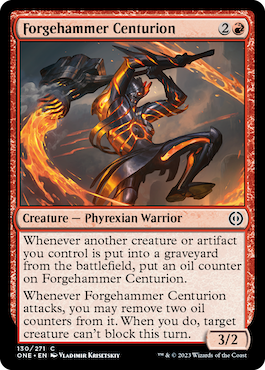
The types of effects that oil counters have vary wildly in the set. Some cards look at how many oil counters are on a permanent, and offer some reward the higher you go. In other cases, like with Forgehammer Centurion, cards have abilities that require removing oil counters. Doing so can benefit you in combat, or in any number of other ways. There are also cards in the set that pay you off for the number of permanents you control with oil counters on them.
Oil counters show up in all five colors in ONE, but are most common in blue, red, and green. Given that these types of counters haven’t been seen before–and the broad range of strategies that seem to want to make use of them–it’s hard to predict exactly how they’ll play, or just how powerful they will be. Look to the cards you’re building with to determine the role that oil counters might look to serve in your particular deck, and go from there.
Proliferate
Tying together toxic, corrupted, and oil counters is the most noteworthy returning mechanic in the set: “Proliferate.” The reminder text reads: “Chose any number of permanents and/or players, then give each another counter of each kind already there.” So, in the context of ONE, this means an extra poison counter, oil counter, or loyalty counter (if you’re lucky enough to pull a planeswalker).
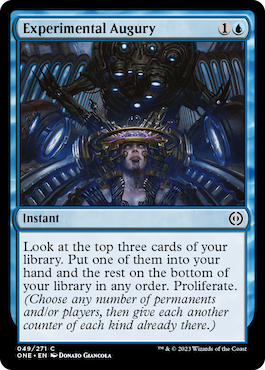
For the most part, proliferate is tacked onto already-decent cards as an small bonus throughout the set. Experimental Augury, for example, is an Anticipate-style spell you might want to play anyway, especially if your deck cares about instants and sorceries. But with proliferate added, it becomes just a bit more enticing in a wider range of strategies. Other cards in the set, such as the blue-black uncommon creature (more on that below), have abilities that trigger whenever you proliferate, regardless of the effect that doing so may have on the rest of your permanents.
Proliferate pops up in every color in ONE, but not in huge numbers; there are certainly more cards in the set that benefit from proliferating than there are cards that proliferate themselves. But given the seeming prevalence of counters-based strategies, the mechanic should fit well into just about any type of deck in the format. It can help keep the oil flowing, get you to corrupted a turn sooner, or even serve the finishing blow of the 10th poison counter on your opponent. Take proliferate cards highly, put them in your deck, and they’ll likely be good.
For Mirrodin!
“For Mirrodin!” (yes, exclamation point included) stands on its own against the four other main mechanics in ONE. Corrupted works with toxic, which works with proliferate, with works with oil counters, etc. But For Mirrodin! has nothing to do with counters of any kind.
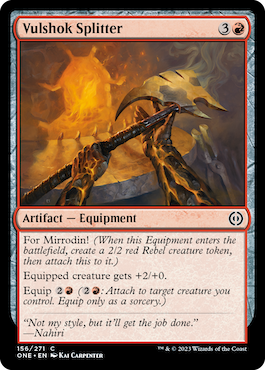
For Mirrodin! is a keyword ability found of many (but not all) equipment cards in the set. When an equipment with For Mirrodin! enters the battlefield, you get a 2/2 red Rebel creature token, and then attach the equipment to it.
The mechanic certainly helps get around the potential pitfall of running too many equipment in your deck–namely, drawing your equipment cards, but not the creatures to attach them to. Therefore, the best way to think about cards with For Mirrodin! is as creatures with some extra utility/flexibility. Vulshok Splitter, for example, can be evaluated as a four-mana 4/2, with the potential of helping pump up some of your other creatures later in the game, once the Rebel creature has died or been outmatched.
For Mirrodin! is primarily a red and white mechanic, though there is one blue and one green card with the ability in the set, as well. There’s not a ton to say about the mechanic overall, though their value can certainly go up if included in a deck with ample artifact and/or equipment synergies (more on that in the “Archetypes” section below).
Archetypes
Understanding the various mechanics of a Magic set is only step one: Step two is figuring out how these mechanics interact with each other across the five colors. To do so, it can be helpful to look at what the 10 different two-color combinations in a set appear to be trying to do–what’s their strategy, what are their strengths and weaknesses compared to the other color pairs, how do their core mechanics interact, etc. Learning what these two-color archetypes look like is most important for preparing for your prerelease or subsequent limited events, but can also serve as valuable jumping-off points for constructed deck building.
It can be difficult to gauge all this before seeing how the cards actually play out in practice. And, at time of publication, Wizards of the Coast hasn’t explicitly stated what the exact archetypes are meant to be. But luckily, as is the case in most modern “expert-level” sets, there is one uncommon creature card for each two-color pair in ONE. These cards are often a good indicator of what that color pair’s primary game plan is all about.
Blue-white: Artifacts
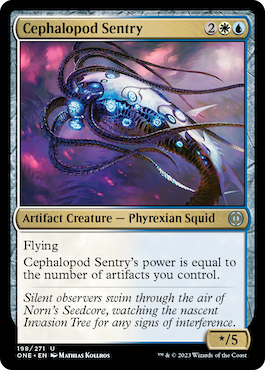
Cephalopod Sentry is just about as clear-cut a signpost uncommon as they come. The strategy appears to simply be, “Play lots of artifacts.”
Luckily, the color pair seems well-prepared to do just that. Nearly half of the white cards in ONE either are artifacts themselves or make 1/1 artifact creature tokens, and blue isn’t far behind. (Not to mention the 25 total colorless artifacts in the set, as well).
Just how aggressive or controlling the archetype may be remains to be seen, but regardless, Cephalopod Sentry appears to be a solid reason to go down the artifact path.
Blue-black: Poison/proliferate

With blue-black, it’s a bit less clear how the archetype might play out. As a two-mana flying creature with toxic, Voiding Hybrid makes turning on corrupted trivial. But with the potential to repeatedly recur it, getting your opponent to 10 poison counters also seems like a viable game plan (especially if you’re proliferating on top of it, which the card is asking you to do anyway).
Whether blue-black will play out as a control deck that leans into corrupted payoffs, or a more assertive, turbo-poison deck is up in the air. But with such good baseline stats and high upside potential, Voidwing Hybrid should do well in just about any deck you can cast it in.
Black-red: Sacrifice/oil

In typical black-red fashion, Charforger benefits you when your creatures or artifacts hit the graveyard from play. It may not have the word “sacrifice” in its text box, but clearly shines most in a deck that can do so.
However, going down the sacrifice path may not even be necessary for this archetype. Charforger can fairly easily get up to three oil counters over the course of the game without much work–creatures die all the time in Magic, after all. There may be a version of black-red that cares more about stacking up oil counters, proliferating, and reaping the rewards, be it with card advantage like we see on Charforger, or with more aggressively slanted effects.
Green-red: Oil
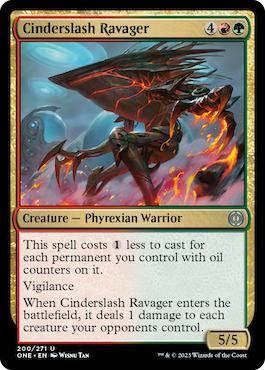
Unlike the previous two gold uncommons, Cinderslash Ravager requires a bit more work. Six mana for a 5/5 vigilance isn’t anything to write home about in terms of efficiency, even if it has the potential to wipe out an opposing X/1 creature or two.
That said, with enough oil spread (smeared?) amongst your permanents on the battlefield, this card can be a huge payoff. It doesn’t care about how many oil counters are on any single card, but rather how many cards have oil counters on them, so effects that can move around or add oil counters to your permanents pair beautifully with this.
Cinderslash Ravager shouldn’t be thrown into a deck willy-nilly; you want to be fairly all-in on oil before you get excited about it. However, cost reduction mechanics are traditionally among the most broken in Magic, and this qualifies. Spending two or three mana on a 5/5 with upside is a potentially game-winning play.
Green-white: Toxic tokens
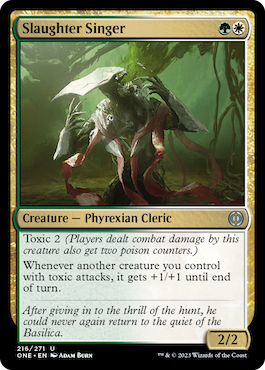
You don’t necessarily need tokens to make Slaughter Singer great–it does its job just fine alongside regular toxic creatures, too–but pairing it with an army of 1/1 Phyrexian Mites that attack as 2/2’s is a match made in heaven. With ample ways to pump out the tokens in white, it shouldn’t be hard to go wide enough for this card to have a profound effect on the game.
With a healthy mix of white’s smaller toxic creatures to flood the board with, and green’s high-toxic trampling beasts, green-white seems like one of the best archetypes for getting your opponent up to 10 poison counters in just a few attack steps.
Black-white: Corrupted
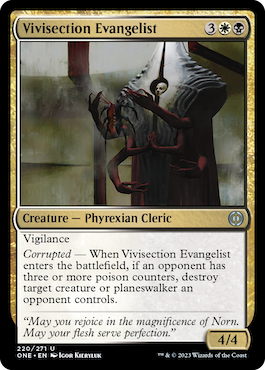
Vivisection Evangelist is just about as great a corrupted payoff as you could ask for. Creatures that destroy opposing creatures when they enter the battlefield have traditionally been among some of the best cards ever printed in Magic.
Based on the texture of black and white’s colors in the set, it seems likely that the archetype will play out like a traditional midrange deck. Unlike the green-based toxic color pairs, black-white is more interested in just getting up to the minimum three poison counters, and then winning the game by grinding the opponent out with the advantages afforded by corrupted.
Green-black: Toxic

It’s hard to tell exactly how green-black will play out, but poison counters are sure to be a central part of the strategy. Necrogen Rotpriest not only increases the poison counters dealt by your toxic creatures, but also has an activated ability that makes them all a nightmare to block. (Worth noting, Necrogen Rotpriest can deal three poison counters on its own, single-handedly turning on corrupted).
With green’s slew of high-toxic creatures, and black’s suite of removal spells to help clear the way for attacks, it may turn out to be one of the best color pairs for killing your opponent via poison counters.
Blue-green: Toxic/proliferate
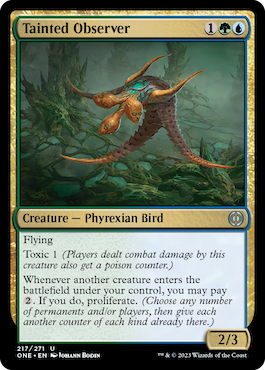
As a toxic 2/3 flier for three mana with a repeatable proliferate ability, Tainted Observer is almost a game plan all on its own. Get in a few hits, then spend the rest of the game playing creatures and activating its ability, and you could get your opponent up to 10 poison counters out of nowhere.
However, poison may not need to be a central part of the archetype for it to be good. Tainted Observer works great with blue’s many oil counter-centric cards, as well. A mix of oil and toxic–along with some classic blue-green ramp–could lead to a solid, if less tunnel-visioned, midrange strategy.
Blue-red: Spells/oil
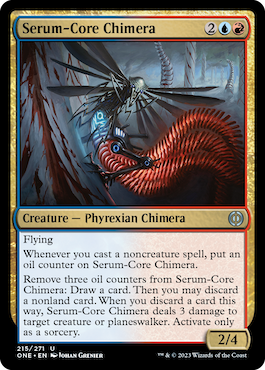
As is almost always the case, blue-red seems to care about casting non-creature spells in this set. In the case of Serum-Core Chimera, the payoff is stacking up oil counters, which can be removed to draw cards and maybe Lightning Bolt something. Unlike some blue-red “spells matter” cards, this one doesn’t require you cast instants and sorceries to get the effect; non-creature artifacts, enchantments, or planeswalkers will trigger it, as well.
Be on the lookout for non-creature spells with incidental proliferate for this archetype, too. Experimental Augury, which we mentioned earlier, will put two oil counters on the Chimera on its own, for example.
Red-white: Equipment
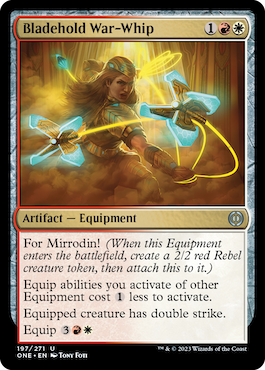
With the bulk of the equipment being in red and white in ONE, it’s only natural for red-white to be the equipment archetype. Bladehold War-Whip, which functions as a three-mana 2/2 double strike, pays you off for having a critical mass of equipment cards on the battlefield to move around on the cheap.
Traditionally, equipment-centric strategies have not been the most competitive in Magic–especially in limited, where the risk of getting blown out by removal or not drawing your creatures and equipment in the right order is so high. However, it’s possible that the For Mirrodin! mechanic changes the equation here. It’s much less risky when your equipment come with power and toughness attached from the start.
Notable card cycles
Like most sets, ONE features a handful of card cycles across the five colors. They range from common to mythic rare, and have vastly varying effects, but you’ll want to keep them in mind when it comes time for deck building.
Planeswalkers
There are planeswalkers printed in every modern Magic set, but it’s not every day that we get 10–five of which being only rare, instead of the standard mythic rarity!
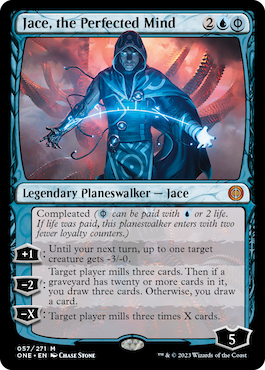
All five of the mythic rare planeswalkers in ONE are “Compleated.” Lore-wise, this means that they’ve reached Phyrexians’ (questionable) ideal of perfection, having become soulless, largely artificial husks of their former selves (poor Jace).
Rules-wise, all compleated planeswalkers have “Phyrexian mana” in their mana costs, which can be paid with either the color represented or two life. If you chose to pay the life, the planeswalker enters with two fewer loyalty counters. It might sound like a bad deal, but Phyrexian mana has proven time and time again to be one of the most broken mechanics ever printed in the game. The flexibility that it grants to the five compleated planeswalkers in the set is huge.
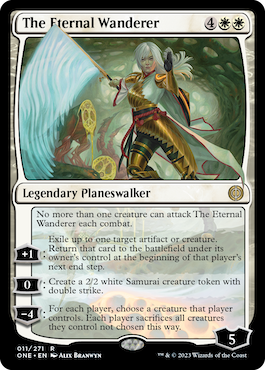
However, the five rare planeswalkers in the set are certainly no slouches, either. The Eternal Wanderer looks to be a particularly unbeatable bomb, especially in limited. Keep in mind that you’ll be seeing these cards more than normal given their lower rarity, and consider trying to include some answers to them when deck-building
Dominus creatures
This is a cycle of mythic rare legendary Phyrexian horror creatures. There is one in each color, and while their stats and static abilities vary wildly, they all share the ability to get “indestructible counters,” but at a steep cost.

With Zopandrel, Hunger Dominus, you get a giant power and toughness doubler. To get the indestructible counter, you must pay two green Phyrexian mana and sacrifice two other creatures.

In the case of Solphim, Mayhem Dominus, your noncombat damage is doubled. Getting your indestructible counter requires discarding two cards, as well as paying three mana, two of which being Phyrexian.
Don’t let the high price of these creatures’ activated abilities scare you away! They’re all well-statted monsters with relevant, sometimes even game-ending static abilities. The flexibility to give them indestructible when you really need to is all upside.
Twilights
Next up is a cycle of rare instants and sorceries, one in each color. They all have “X” in their casting cost, and they all benefit you greatly when X is five or more.
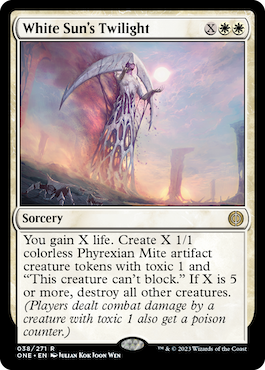
These cards may prove to be too inefficient to be big players in high-level constructed formats. But at your prerelease, or any other subsequent limited event, you should do everything in your power to include them in your deck. They all have devastatingly game-swinging effects when you get X up to five, with the white, blue, and black ones being the best of the bunch by a good margin.
Skullbombs
This common cycle of artifacts all cost one generic mana, and can all be sacrificed for one generic mana to draw a card. In addition, they all have a second activated ability–one for each color–that provides a minor bonus, while also still drawing you a card.

These cards may look innocuous at first glance. None of the effects that they provide are particularly exciting, after all. However, they may prove to be important players in the format for the synergy they provide by upping your artifact count and serving as sacrifice fodder. Also, don’t underestimate cheap cards that draw you a card in return. They’re essentially “free,” and probably better than you think!
Fast lands
The rare “fast lands” are back, this time in the five allied color pairs.
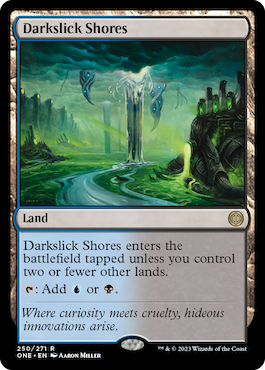
They may not be the most exciting card to see in your rare slot at the prerelease. That said, they are certainly good at what they do! The fast lands will surely see tons of play in Standard, and should definitely be included in your limited decks when possible, as well.
Sphere lands
The other land cycle in ONE is the “Spheres.” These common lands tap for one color, enter the battlefield tapped, and can be tapped and sacrificed for two mana (one being the color that the land itself produces) to draw a card.
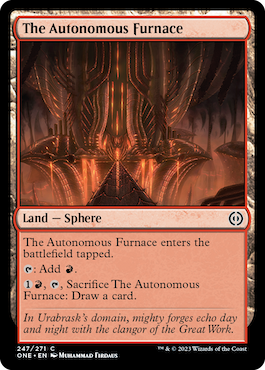
Entering the battlefield tapped is a real cost, so you probably don’t want to throw too many of these into your deck. However, the ability to turn one of your lands into a new card in the late-game is a nice bit of value. Most limited decks would probably be well served running one or two of these in their colors for good measure.
Other notable cards
There are far too many cards in the set with the potential to impact both limited and constructed Magic to list here. However, there are a few standouts to keep your eyes peeled for when cracking packs at your prerelease and beyond.
Elesh Norn, Mother of Machines

We’d be remiss not to mention the true villain of Phyrexia, Elesh Norn. As a five-mana 4/7 vigilance, she’s already a great card on stats alone, and one you should include in any white deck. Her first static ability may look like a “build-around” at first glance, but it’s really not. Just about any deck in constructed and limited alike will be full of cards with ETB abilities, without even doing any work. For the same reason, her second static ability will almost assuredly be good in any game of Magic. Elesh Norn is a true bomb, and a fitting signpost card for everything going on in the format.
Phyrexian Obliterator/Vindicator

A notable reprint in ONE is the ever-terrifying Phyrexian Obliterator. This is a huge threat when on the battlefield. However, with such a demanding mana cost, casting it is no small feat. You basically only want to include it in a mono-black deck. But in such a shell, it can have a devastating effect on a game. It will likely be more of a player in constructed, where getting away with a mono-colored deck is more attainable than in limited.

Alongside it is a new card, Phyrexian Vindicator. It has the same base stats at Obliterator, but with flying instead of trample and the ability to prevent all damage dealt to it and instead deal that much damage to anything, it may prove to be even more powerful. Again, save this for your mono-white decks.
Phyrexian Arena
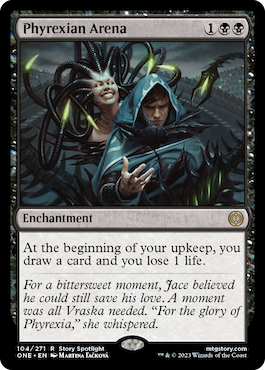
Another noteworthy reprint is the enchantment, Phyrexian Arena. Any effect that draws you an extra card a turn is worth paying attention to. The life loss is a real cost that can stack up over time, but this can be offset but slotting the card into it deck with some life-gain effects, or simply a hyper-aggressive deck where you can get your opponent’s life total to zero before the life loss has the chance to catch up to you.
Thrun, Breaker of Silence

A new take on a classic Magic character first introduced in Mirrodin Besieged, Thrun, Breaker of Silence is the ultimate hoser of blue, controlling strategies. Thrun is a true bomb in limited, and you should do everything in your power to include it in your deck if you’re lucky enough to open it at your prerelease. It’s likely to have constructed implications, as well, especially as a sideboard option against decks with lots of counters and removal spells.
Atraxa, Grand Unifier
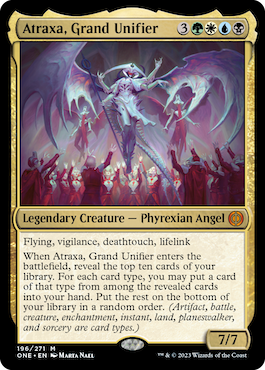
The fearsome Legendary Phyrexian Angel Horror has been reimagined in ONE at Atraxa, Grand Unifier. It hosts the same laundry list of keyword abilities as the original Atraxa, Praetor’s Voice, but it’s bigger, more expensive, and now draws cards instead of proliferating. In the right deck, Atraxa has the potential to draw you upwards of four-plus cards, and give you selection while doing so. As a four-color card, you need to do some work to make your mana base support casting Atraxa. But if you do, it can pay you off handsomely.
Sword of Forge and Frontier
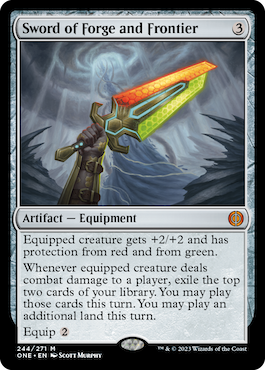
Last on the list is the newest mythic rare Mirran sword. It is the fourth allied-color protection sword, which were first introduced in Modern Horizons in 2019. Here, it grants protection from red and green, and essentially draws you two cards whenever you deal damage to a player with equipped creature.
Almost every sword printed in Magic has been exceptionally powerful, and Sword of Forge and Frontier does not seem to be an exception. With the solid power and toughness buff for the low cost of two to equip, and the potential to make your creature both unblockable and un-killable against the right deck, this card should be an auto-include in any limited deck with creatures, and only goes up in value once you have artifact or equipment themes going. How it fits into the landscape of constructed remains to be seen.
How to play
That’s it for the breakdown of Phyrexia: All Will Be One! The set officially releases on Arena on February 7, and for tabletop on February 10. However, during the weekend of February 3-5, you can get your hands on the cards early at a prerelease. To find an LGS hosting prerelease events near you, check out Wizards of the Coasts’ event locator. Good luck, and have fun!
The products discussed here were independently chosen by our editors.
GameSpot may get a share of the revenue if you buy anything featured on our site.




